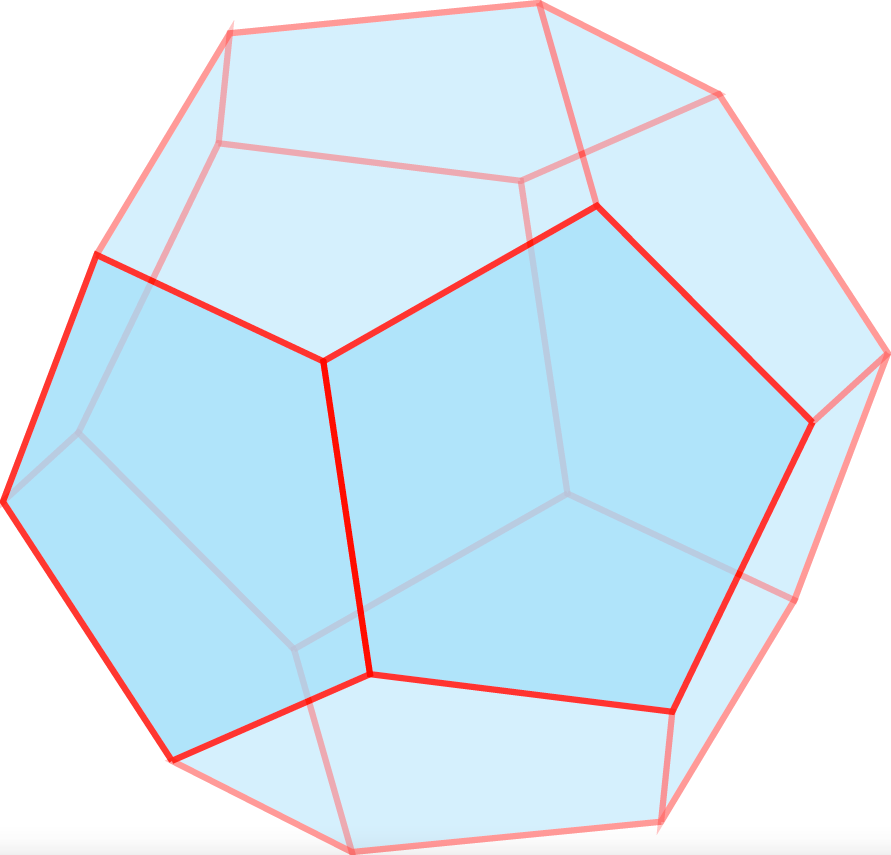Edit and compile if you like:
\documentclass{article}
\usepackage{tikz}
\usepackage{tikz-3dplot}
\usepackage[active,tightpage]{preview}
\PreviewEnvironment{tikzpicture}
\setlength\PreviewBorder{0.125pt}
%
% File name: adjacent-faces-dodecahedron.tex
% Description:
% Two adjacent faces of the dodechedron are shown.
%
% Date of creation: July, 13th, 2021.
% Date of last modification: October, 9th, 2022.
% Author: Efraín Soto Apolinar.
% https://www.aprendematematicas.org.mx/author/efrain-soto-apolinar/instructing-courses/
% Source: page 2 of the
% Glosario Ilustrado de Matem\'aticas Escolares.
% https://tinyurl.com/5udm2ufy
%
% Terms of use:
% According to TikZ.net
% https://creativecommons.org/licenses/by-nc-sa/4.0/
% Your commitment to the terms of use is greatly appreciated.
%
\begin{document}
\tdplotsetmaincoords{70}{110}
%
\begin{tikzpicture}[tdplot_main_coords]
% in order to scale the polyhedron change the value of {\escala}{##}
\pgfmathsetmacro{\escala}{1.5}
% Coordinates of the vertices
\coordinate(1) at (-\escala*1.37638, \escala*0., \escala*0.262866);
\coordinate(2) at (\escala*1.37638, \escala*0., -\escala*0.262866);
\coordinate(3) at (-\escala*0.425325, -\escala*1.30902, \escala*0.262866);
\coordinate(4) at (-\escala*0.425325, \escala*1.30902, \escala*0.262866);
\coordinate(5) at (\escala*1.11352, -\escala*0.809017, \escala*0.262866);
\coordinate(6) at (\escala*1.11352, \escala*0.809017, \escala*0.262866);
\coordinate(7) at (-\escala*0.262866, -\escala*0.809017, \escala*1.11352);
\coordinate(8) at (-\escala*0.262866, \escala*0.809017, \escala*1.11352);
\coordinate(9) at (-\escala*0.688191, -\escala*0.5, -\escala*1.11352);
\coordinate(10) at (-\escala*0.688191, \escala*0.5, -\escala*1.11352);
%
\coordinate(11) at (\escala*0.688191, -\escala*0.5, \escala*1.11352);
\coordinate(12) at (\escala*0.688191, \escala*0.5, \escala*1.11352);
\coordinate(13) at (\escala*0.850651, \escala*0., -\escala*1.11352);
\coordinate(14) at (-\escala*1.11352, -\escala*0.809017, -\escala*0.262866);
\coordinate(15) at (-\escala*1.11352, \escala*0.809017, -\escala*0.262866);
\coordinate(16) at (-\escala*0.850651, \escala*0., \escala*1.11352);
\coordinate(17) at (\escala*0.262866, -\escala*0.809017, -\escala*1.11352);
\coordinate(18) at (\escala*0.262866, \escala*0.809017, -\escala*1.11352);
\coordinate(19) at (\escala*0.425325, -\escala*1.30902, -\escala*0.262866);
\coordinate(20) at (\escala*0.425325, \escala*1.30902, -\escala*0.262866);
% The faces of the polyhedron (dodecahedron)
\draw[red,thick,fill=cyan!35,opacity=0.25] (2) -- (6) -- (12) -- (11) -- (5) -- (2);
\draw[red,thick,fill=cyan!35,opacity=0.25] (5) -- (11) -- (7) -- (3) -- (19) -- (5);
\draw[red,thick,fill=cyan!35,opacity=0.25] (11) -- (12) -- (8) -- (16) -- (7) -- (11);
\draw[red,thick,fill=cyan!35,opacity=0.25] (12) -- (6) -- (20) -- (4) -- (8) -- (12);
%
\draw[red,thick,fill=cyan!35,opacity=0.25] (6) -- (2) -- (13) -- (18) -- (20) -- (6);
\draw[red,thick,fill=cyan!35,opacity=0.25] (2) -- (5) -- (19) -- (17) -- (13) -- (2);
\draw[red,thick,fill=cyan!35,opacity=0.25] (4) -- (20) -- (18) -- (10) -- (15) -- (4);
\draw[red,thick,fill=cyan!35,opacity=0.25] (18) -- (13) -- (17) -- (9) -- (10) -- (18);
\draw[red,thick,fill=cyan!35,opacity=0.75] (17) -- (19) -- (3) -- (14) -- (9) -- (17); % Adjacent face 1
%
\draw[red,thick,fill=cyan!35,opacity=0.25] (3) -- (7) -- (16) -- (1) -- (14) -- (3);
\draw[red,thick,fill=cyan!35,opacity=0.25] (16) -- (8) -- (4) -- (15) -- (1) -- (16);
\draw[red,thick,fill=cyan!35,opacity=0.75] (15) -- (10) -- (9) -- (14) -- (1) -- (15); % Adjacent face 2
%
\end{tikzpicture}
%
\end{document}
Click to download: adjacent-faces-dodecahedron.tex • adjacent-faces-dodecahedron.pdf
Open in Overleaf: adjacent-faces-dodecahedron.tex
See more on the author page of Efraín Soto Apolinar.


